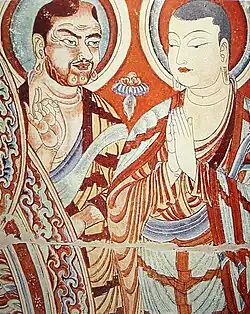


Right image: Pranidhi scene, temple 9 (Cave 20), with kneeling figures praying in front of the Buddha who Albert von Le Coq assumed were Persian people (German: "Perser"), noting their Caucasian features and green eyes, as well as the donkey and Central-Asian Bactrian camel loaded with tributary goods.[5] However, modern scholarship has identified praṇidhi scenes of the same temple (No. 9) as depicting ethnic Sogdians,[3] an Eastern Iranian people who inhabited Turfan as an ethnic minority community during the phases of Tang Chinese (7th-8th century) and Uyghur rule (9th-13th century).[4]
Theodor Bartus (January 30, 1858 in Lassan, Germany – January 28, 1941 in Berlin) was a German sailor, museum technician, and conservator. Bartus was the son of a master weaver. He began his nautical career on the sailing ship of his uncle. In Australia, he passed his First mate exam and became captain. He acquired many years of experience sailing ships. At times, he lived as a squatter in Australia.[6]
During a visit to Germany, his Australian bank went bankrupt, and he became suddenly destitute. Forced to find a job, he worked from 1888 as a museum technician at the Ethnological Museum of Berlin, where he rigged vessels.
Between 1902 and 1914, he was a technical crew member on all four German Turfan expeditions headed by Albert Grünwedel and Albert von Le Coq. Bartus developed a method of detaching mural paintings and inscriptions from caves, rock walls, and ruins, leaving them largely undamaged, which were then transported to Germany. Until his death, he was employed at the museum, preparing and preserving the finds he brought back from Turfan.
References
- Bartus, Theodor. "Grete Grewolls: Wer war wer in Mecklenburg-Vorpommern?" In Personenlexikon. Edition Temmen, Bremen 1995, ISBN 3-86108-282-9, S. 32. (German language)
- Knüppel, Michael: "Theodor Bartus (1858–1941) – Anmerkungen zu seinem siebzigsten Todestag". In: Pommern. Zeitschrift für Kultur und Geschichte. Heft 4/2010, ISSN 0032-4167, S. 14–18. (German language)
Notes
- ↑ Footprints of Foreign Explorers on the Silk Road. 五洲传播出版社. p. 86. ISBN 978-7-5085-0706-4.
- ↑ von Le Coq, Albert. (1913). Chotscho: Facsimile-Wiedergaben der Wichtigeren Funde der Ersten Königlich Preussischen Expedition nach Turfan in Ost-Turkistan. Berlin: Dietrich Reimer (Ernst Vohsen), im Auftrage der Gernalverwaltung der Königlichen Museen aus Mitteln des Baessler-Institutes, Tafel 19. (Accessed 3 September 2016).
- 1 2 Gasparini, Mariachiara. "A Mathematic Expression of Art: Sino-Iranian and Uighur Textile Interactions and the Turfan Textile Collection in Berlin," in Rudolf G. Wagner and Monica Juneja (eds), Transcultural Studies, Ruprecht-Karls Universität Heidelberg, No 1 (2014), pp 134-163. ISSN 2191-6411. See also endnote #32. (Accessed 3 September 2016.)
- 1 2 Hansen, Valerie (2012), The Silk Road: A New History, Oxford University Press, p. 98, ISBN 978-0-19-993921-3.
- ↑ von Le Coq, Albert. (1913). Chotscho: Facsimile-Wiedergaben der Wichtigeren Funde der Ersten Königlich Preussischen Expedition nach Turfan in Ost-Turkistan. Berlin: Dietrich Reimer (Ernst Vohsen), im Auftrage der Gernalverwaltung der Königlichen Museen aus Mitteln des Baessler-Institutes, p. 28, Tafel 20. (Accessed 3 September 2016).
- ↑ Albert von Le Coq: Auf Hellas Spuren in Ost-Turkestan. Berichte und Abenteuer der II. und III. deutschen Turfan-Expedition. J. C. Hinrichs, Leipzig 1926. S. 28. (Digitalisat im Digital Archive of Toyo Bunko Rare Books)